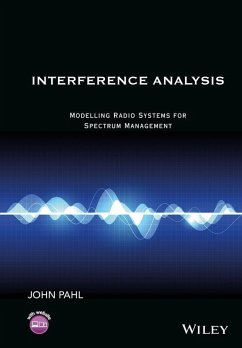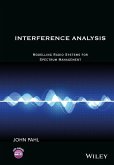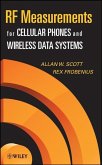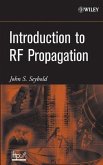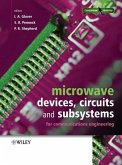99,99 €
99,99 €
inkl. MwSt.
Sofort per Download lieferbar

0 °P sammeln
99,99 €
Als Download kaufen

99,99 €
inkl. MwSt.
Sofort per Download lieferbar

0 °P sammeln
Jetzt verschenken
Alle Infos zum eBook verschenken
99,99 €
inkl. MwSt.
Sofort per Download lieferbar
Alle Infos zum eBook verschenken

0 °P sammeln
- Format: PDF
- Merkliste
- Auf die Merkliste
- Bewerten Bewerten
- Teilen
- Produkt teilen
- Produkterinnerung
- Produkterinnerung

Bitte loggen Sie sich zunächst in Ihr Kundenkonto ein oder registrieren Sie sich bei
bücher.de, um das eBook-Abo tolino select nutzen zu können.
Hier können Sie sich einloggen
Hier können Sie sich einloggen
Sie sind bereits eingeloggt. Klicken Sie auf 2. tolino select Abo, um fortzufahren.

Bitte loggen Sie sich zunächst in Ihr Kundenkonto ein oder registrieren Sie sich bei bücher.de, um das eBook-Abo tolino select nutzen zu können.
The book describes how interference can be managed so that radio systems co-exist, without harmful mutual effects, within a finite amount of spectrum. This is timely in view of the increasing proliferation of wireless systems. It covers both the processes, such as regional or international coordination, as well as the engineering principles. Written by an author with extensive experience in the industry, it describes in detail the main methodologies for calculating or computing the interference between radio systems of the same type, and also between radio systems of different types
- Geräte: PC
- mit Kopierschutz
- eBook Hilfe
- Größe: 16.44MB
Andere Kunden interessierten sich auch für
![Interference Analysis (eBook, ePUB) Interference Analysis (eBook, ePUB)]() John PahlInterference Analysis (eBook, ePUB)99,99 €
John PahlInterference Analysis (eBook, ePUB)99,99 €![RF Measurements for Cellular Phones and Wireless Data Systems (eBook, PDF) RF Measurements for Cellular Phones and Wireless Data Systems (eBook, PDF)]() Allen W. ScottRF Measurements for Cellular Phones and Wireless Data Systems (eBook, PDF)138,99 €
Allen W. ScottRF Measurements for Cellular Phones and Wireless Data Systems (eBook, PDF)138,99 €![Introduction to RF Propagation (eBook, PDF) Introduction to RF Propagation (eBook, PDF)]() John S. SeyboldIntroduction to RF Propagation (eBook, PDF)116,99 €
John S. SeyboldIntroduction to RF Propagation (eBook, PDF)116,99 €![RF and Microwave Wireless Systems (eBook, PDF) RF and Microwave Wireless Systems (eBook, PDF)]() Kai ChangRF and Microwave Wireless Systems (eBook, PDF)152,99 €
Kai ChangRF and Microwave Wireless Systems (eBook, PDF)152,99 €![Microwave Devices, Circuits and Subsystems for Communications Engineering (eBook, PDF) Microwave Devices, Circuits and Subsystems for Communications Engineering (eBook, PDF)]() Microwave Devices, Circuits and Subsystems for Communications Engineering (eBook, PDF)173,99 €
Microwave Devices, Circuits and Subsystems for Communications Engineering (eBook, PDF)173,99 €![Cognitive Radio, Software Defined Radio, and Adaptive Wireless Systems (eBook, PDF) Cognitive Radio, Software Defined Radio, and Adaptive Wireless Systems (eBook, PDF)]() Cognitive Radio, Software Defined Radio, and Adaptive Wireless Systems (eBook, PDF)113,95 €
Cognitive Radio, Software Defined Radio, and Adaptive Wireless Systems (eBook, PDF)113,95 €![Coupled-Oscillator Based Active-Array Antennas (eBook, PDF) Coupled-Oscillator Based Active-Array Antennas (eBook, PDF)]() Ronald J. PogorzelskiCoupled-Oscillator Based Active-Array Antennas (eBook, PDF)136,99 €
Ronald J. PogorzelskiCoupled-Oscillator Based Active-Array Antennas (eBook, PDF)136,99 €-
-
-
The book describes how interference can be managed so that radio systems co-exist, without harmful mutual effects, within a finite amount of spectrum. This is timely in view of the increasing proliferation of wireless systems. It covers both the processes, such as regional or international coordination, as well as the engineering principles. Written by an author with extensive experience in the industry, it describes in detail the main methodologies for calculating or computing the interference between radio systems of the same type, and also between radio systems of different types
Dieser Download kann aus rechtlichen Gründen nur mit Rechnungsadresse in D ausgeliefert werden.
Produktdetails
- Produktdetails
- Verlag: John Wiley & Sons
- Erscheinungstermin: 12. April 2016
- Englisch
- ISBN-13: 9781119065319
- Artikelnr.: 44896432
- Verlag: John Wiley & Sons
- Erscheinungstermin: 12. April 2016
- Englisch
- ISBN-13: 9781119065319
- Artikelnr.: 44896432
- Herstellerkennzeichnung Die Herstellerinformationen sind derzeit nicht verfügbar.
John Andrew Pahl, Director, Transfinite Systems Ltd, UK
Pahl has worked in the field of interference analysis since the late 1980s and is director of a company specializing in this field. The company undertakes consultancy work, and has clients involved in many different types of radio systems from mobile to satellite to fixed, exposing the author to a wider range of technologies and methodologies than many in the field. He receives regular invitations to Chair international conferences, and is a recognized world expert in Equivalent Power Flux Density (EPFD) analysis under Article 22 of the Radio Regulations. He is an experienced trainer and writer, having given dozens of training courses for his company and helping his clients understand the issues involved in interference analysis. Pahl is ideally placed, therefore, to write this book which is aimed at the professional market he inhabits.
Pahl has worked in the field of interference analysis since the late 1980s and is director of a company specializing in this field. The company undertakes consultancy work, and has clients involved in many different types of radio systems from mobile to satellite to fixed, exposing the author to a wider range of technologies and methodologies than many in the field. He receives regular invitations to Chair international conferences, and is a recognized world expert in Equivalent Power Flux Density (EPFD) analysis under Article 22 of the Radio Regulations. He is an experienced trainer and writer, having given dozens of training courses for his company and helping his clients understand the issues involved in interference analysis. Pahl is ideally placed, therefore, to write this book which is aimed at the professional market he inhabits.
Foreword xiii
Preface xv
1 Introduction 1
1.1 Motivations and Target Audience 2
1.2 Book Structure 2
1.3 Chapter Structure and Additional Resources 3
1.4 Case Study: How to Observe Interference 3
2 Motivations 6
2.1 Why Undertake Interference Analysis? 6
2.2 Drivers of Change 7
2.3 The Regulatory Framework 8
2.4 International Regulations 10
2.5 Updating the Radio Regulations and Recommendations 27
2.6 Meetings and Presenting Results 29
2.7 National Regulators 34
2.8 Regional and Industry Organisations 35
2.9 Frequency Assignment and Planning 37
2.10 Coordination 40
2.11 Types of Interference Analysis 42
2.12 Further Reading and Next Steps 42
3 Fundamental Concepts 43
3.1 Radiocommunication Systems 43
3.2 Radio Waves and Decibels 46
3.3 The Power Calculation 49
3.4 Carrier Types and Modulation 52
3.5 Multiple Access Methods 66
3.6 Noise Temperature and Reference Points 75
3.7 Antennas 82
3.8 Geometry and Dynamics 101
3.9 Calculation of Angles 122
3.10 Statistics and Distributions 128
3.11 Link Budgets and Metrics 133
3.12 Spectrum Efficiency and Requirements 138
3.13 Worked Example 140
3.14 Further Reading and Next Steps 142
4 Propagation Models 144
4.1 Overview 145
4.2 The Propagation Environment 148
4.3 Terrestrial Propagation Models 160
4.4 Earth to Space Propagation Models 199
4.5 Aeronautical Propagation Models 205
4.6 Additional Attenuations 205
4.7 Radio Path Geometry 208
4.8 Percentages of Time and Correlation 209
4.9 Selection of Propagation Model 214
4.10 Further Reading and Next Steps 216
5 The Interference Calculation 217
5.1 Bandwidths and Domains 218
5.2 Bandwidth Adjustment Factor 221
5.3 Spectrum Masks, Ratios and Guard Bands 224
5.4 Polarisation 254
5.5 Adaptive Systems: Frequency, Power and Modulation 258
5.6 End-to-End Performance 263
5.7 Modelling Deployment and Traffic 266
5.8 Link Design and Margin 276
5.9 Interference Apportionment and Thresholds 281
5.10 Types of Interference Thresholds 292
5.11 Interference Mitigation 314
5.12 Further Reading and Next Steps 327
6 Interference Analysis Methodologies 328
6.1 Methodologies and Studies 329
6.2 Example Scenarios 331
6.3 Static Analysis 338
6.4 Input Variation Analysis 344
6.5 Area and Boundary Analysis 347
6.6 Minimum Coupling Loss and Required Separation Distance 353
6.7 Analytic Analysis 357
6.8 Dynamic Analysis 363
6.9 Monte Carlo Analysis 373
6.10 Area and Two-Stage Monte Carlo 395
6.11 Probabilistic Analysis 401
6.12 Selection of Methodology 402
6.13 Study Projects and Working Methods 404
6.14 Further Reading and Next Steps 407
7 Specific Algorithms and Services 408
7.1 Fixed Service Planning 409
7.2 Private Mobile Radio 417
7.3 Broadcasting 431
7.4 Earth Station Coordination 443
7.5 GSO Satellite Coordination 450
7.6 EPFD and Rec. ITU-R S. 1503 467
7.7 The Radar Equation 483
7.8 N-Systems Methodology 488
7.9 Generic Radio Modelling Tool 494
7.10 White Space Devices 501
7.11 Final Thoughts 514
References 515
Acronyms, Abbreviations and Symbols 522
Index 530
Preface xv
1 Introduction 1
1.1 Motivations and Target Audience 2
1.2 Book Structure 2
1.3 Chapter Structure and Additional Resources 3
1.4 Case Study: How to Observe Interference 3
2 Motivations 6
2.1 Why Undertake Interference Analysis? 6
2.2 Drivers of Change 7
2.3 The Regulatory Framework 8
2.4 International Regulations 10
2.5 Updating the Radio Regulations and Recommendations 27
2.6 Meetings and Presenting Results 29
2.7 National Regulators 34
2.8 Regional and Industry Organisations 35
2.9 Frequency Assignment and Planning 37
2.10 Coordination 40
2.11 Types of Interference Analysis 42
2.12 Further Reading and Next Steps 42
3 Fundamental Concepts 43
3.1 Radiocommunication Systems 43
3.2 Radio Waves and Decibels 46
3.3 The Power Calculation 49
3.4 Carrier Types and Modulation 52
3.5 Multiple Access Methods 66
3.6 Noise Temperature and Reference Points 75
3.7 Antennas 82
3.8 Geometry and Dynamics 101
3.9 Calculation of Angles 122
3.10 Statistics and Distributions 128
3.11 Link Budgets and Metrics 133
3.12 Spectrum Efficiency and Requirements 138
3.13 Worked Example 140
3.14 Further Reading and Next Steps 142
4 Propagation Models 144
4.1 Overview 145
4.2 The Propagation Environment 148
4.3 Terrestrial Propagation Models 160
4.4 Earth to Space Propagation Models 199
4.5 Aeronautical Propagation Models 205
4.6 Additional Attenuations 205
4.7 Radio Path Geometry 208
4.8 Percentages of Time and Correlation 209
4.9 Selection of Propagation Model 214
4.10 Further Reading and Next Steps 216
5 The Interference Calculation 217
5.1 Bandwidths and Domains 218
5.2 Bandwidth Adjustment Factor 221
5.3 Spectrum Masks, Ratios and Guard Bands 224
5.4 Polarisation 254
5.5 Adaptive Systems: Frequency, Power and Modulation 258
5.6 End-to-End Performance 263
5.7 Modelling Deployment and Traffic 266
5.8 Link Design and Margin 276
5.9 Interference Apportionment and Thresholds 281
5.10 Types of Interference Thresholds 292
5.11 Interference Mitigation 314
5.12 Further Reading and Next Steps 327
6 Interference Analysis Methodologies 328
6.1 Methodologies and Studies 329
6.2 Example Scenarios 331
6.3 Static Analysis 338
6.4 Input Variation Analysis 344
6.5 Area and Boundary Analysis 347
6.6 Minimum Coupling Loss and Required Separation Distance 353
6.7 Analytic Analysis 357
6.8 Dynamic Analysis 363
6.9 Monte Carlo Analysis 373
6.10 Area and Two-Stage Monte Carlo 395
6.11 Probabilistic Analysis 401
6.12 Selection of Methodology 402
6.13 Study Projects and Working Methods 404
6.14 Further Reading and Next Steps 407
7 Specific Algorithms and Services 408
7.1 Fixed Service Planning 409
7.2 Private Mobile Radio 417
7.3 Broadcasting 431
7.4 Earth Station Coordination 443
7.5 GSO Satellite Coordination 450
7.6 EPFD and Rec. ITU-R S. 1503 467
7.7 The Radar Equation 483
7.8 N-Systems Methodology 488
7.9 Generic Radio Modelling Tool 494
7.10 White Space Devices 501
7.11 Final Thoughts 514
References 515
Acronyms, Abbreviations and Symbols 522
Index 530
Foreword xiii
Preface xv
1 Introduction 1
1.1 Motivations and Target Audience 2
1.2 Book Structure 2
1.3 Chapter Structure and Additional Resources 3
1.4 Case Study: How to Observe Interference 3
2 Motivations 6
2.1 Why Undertake Interference Analysis? 6
2.2 Drivers of Change 7
2.3 The Regulatory Framework 8
2.4 International Regulations 10
2.5 Updating the Radio Regulations and Recommendations 27
2.6 Meetings and Presenting Results 29
2.7 National Regulators 34
2.8 Regional and Industry Organisations 35
2.9 Frequency Assignment and Planning 37
2.10 Coordination 40
2.11 Types of Interference Analysis 42
2.12 Further Reading and Next Steps 42
3 Fundamental Concepts 43
3.1 Radiocommunication Systems 43
3.2 Radio Waves and Decibels 46
3.3 The Power Calculation 49
3.4 Carrier Types and Modulation 52
3.5 Multiple Access Methods 66
3.6 Noise Temperature and Reference Points 75
3.7 Antennas 82
3.8 Geometry and Dynamics 101
3.9 Calculation of Angles 122
3.10 Statistics and Distributions 128
3.11 Link Budgets and Metrics 133
3.12 Spectrum Efficiency and Requirements 138
3.13 Worked Example 140
3.14 Further Reading and Next Steps 142
4 Propagation Models 144
4.1 Overview 145
4.2 The Propagation Environment 148
4.3 Terrestrial Propagation Models 160
4.4 Earth to Space Propagation Models 199
4.5 Aeronautical Propagation Models 205
4.6 Additional Attenuations 205
4.7 Radio Path Geometry 208
4.8 Percentages of Time and Correlation 209
4.9 Selection of Propagation Model 214
4.10 Further Reading and Next Steps 216
5 The Interference Calculation 217
5.1 Bandwidths and Domains 218
5.2 Bandwidth Adjustment Factor 221
5.3 Spectrum Masks, Ratios and Guard Bands 224
5.4 Polarisation 254
5.5 Adaptive Systems: Frequency, Power and Modulation 258
5.6 End-to-End Performance 263
5.7 Modelling Deployment and Traffic 266
5.8 Link Design and Margin 276
5.9 Interference Apportionment and Thresholds 281
5.10 Types of Interference Thresholds 292
5.11 Interference Mitigation 314
5.12 Further Reading and Next Steps 327
6 Interference Analysis Methodologies 328
6.1 Methodologies and Studies 329
6.2 Example Scenarios 331
6.3 Static Analysis 338
6.4 Input Variation Analysis 344
6.5 Area and Boundary Analysis 347
6.6 Minimum Coupling Loss and Required Separation Distance 353
6.7 Analytic Analysis 357
6.8 Dynamic Analysis 363
6.9 Monte Carlo Analysis 373
6.10 Area and Two-Stage Monte Carlo 395
6.11 Probabilistic Analysis 401
6.12 Selection of Methodology 402
6.13 Study Projects and Working Methods 404
6.14 Further Reading and Next Steps 407
7 Specific Algorithms and Services 408
7.1 Fixed Service Planning 409
7.2 Private Mobile Radio 417
7.3 Broadcasting 431
7.4 Earth Station Coordination 443
7.5 GSO Satellite Coordination 450
7.6 EPFD and Rec. ITU-R S. 1503 467
7.7 The Radar Equation 483
7.8 N-Systems Methodology 488
7.9 Generic Radio Modelling Tool 494
7.10 White Space Devices 501
7.11 Final Thoughts 514
References 515
Acronyms, Abbreviations and Symbols 522
Index 530
Preface xv
1 Introduction 1
1.1 Motivations and Target Audience 2
1.2 Book Structure 2
1.3 Chapter Structure and Additional Resources 3
1.4 Case Study: How to Observe Interference 3
2 Motivations 6
2.1 Why Undertake Interference Analysis? 6
2.2 Drivers of Change 7
2.3 The Regulatory Framework 8
2.4 International Regulations 10
2.5 Updating the Radio Regulations and Recommendations 27
2.6 Meetings and Presenting Results 29
2.7 National Regulators 34
2.8 Regional and Industry Organisations 35
2.9 Frequency Assignment and Planning 37
2.10 Coordination 40
2.11 Types of Interference Analysis 42
2.12 Further Reading and Next Steps 42
3 Fundamental Concepts 43
3.1 Radiocommunication Systems 43
3.2 Radio Waves and Decibels 46
3.3 The Power Calculation 49
3.4 Carrier Types and Modulation 52
3.5 Multiple Access Methods 66
3.6 Noise Temperature and Reference Points 75
3.7 Antennas 82
3.8 Geometry and Dynamics 101
3.9 Calculation of Angles 122
3.10 Statistics and Distributions 128
3.11 Link Budgets and Metrics 133
3.12 Spectrum Efficiency and Requirements 138
3.13 Worked Example 140
3.14 Further Reading and Next Steps 142
4 Propagation Models 144
4.1 Overview 145
4.2 The Propagation Environment 148
4.3 Terrestrial Propagation Models 160
4.4 Earth to Space Propagation Models 199
4.5 Aeronautical Propagation Models 205
4.6 Additional Attenuations 205
4.7 Radio Path Geometry 208
4.8 Percentages of Time and Correlation 209
4.9 Selection of Propagation Model 214
4.10 Further Reading and Next Steps 216
5 The Interference Calculation 217
5.1 Bandwidths and Domains 218
5.2 Bandwidth Adjustment Factor 221
5.3 Spectrum Masks, Ratios and Guard Bands 224
5.4 Polarisation 254
5.5 Adaptive Systems: Frequency, Power and Modulation 258
5.6 End-to-End Performance 263
5.7 Modelling Deployment and Traffic 266
5.8 Link Design and Margin 276
5.9 Interference Apportionment and Thresholds 281
5.10 Types of Interference Thresholds 292
5.11 Interference Mitigation 314
5.12 Further Reading and Next Steps 327
6 Interference Analysis Methodologies 328
6.1 Methodologies and Studies 329
6.2 Example Scenarios 331
6.3 Static Analysis 338
6.4 Input Variation Analysis 344
6.5 Area and Boundary Analysis 347
6.6 Minimum Coupling Loss and Required Separation Distance 353
6.7 Analytic Analysis 357
6.8 Dynamic Analysis 363
6.9 Monte Carlo Analysis 373
6.10 Area and Two-Stage Monte Carlo 395
6.11 Probabilistic Analysis 401
6.12 Selection of Methodology 402
6.13 Study Projects and Working Methods 404
6.14 Further Reading and Next Steps 407
7 Specific Algorithms and Services 408
7.1 Fixed Service Planning 409
7.2 Private Mobile Radio 417
7.3 Broadcasting 431
7.4 Earth Station Coordination 443
7.5 GSO Satellite Coordination 450
7.6 EPFD and Rec. ITU-R S. 1503 467
7.7 The Radar Equation 483
7.8 N-Systems Methodology 488
7.9 Generic Radio Modelling Tool 494
7.10 White Space Devices 501
7.11 Final Thoughts 514
References 515
Acronyms, Abbreviations and Symbols 522
Index 530
